The Time Traveler's Diary: A Year in YU-NO (2017-2018)
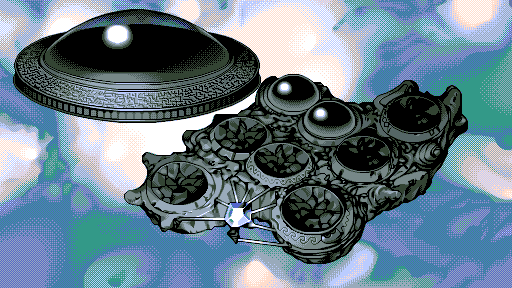
Winter 2017
"In any case, I believe that YU-NO is a work constructed with extreme care, depicting the double-layer structure of database consumption (in the system of the 'Present World Episode'), the ways of life in multiple personality (in the drama of the 'Present World Episode'), and the limit of fantasy in narrative consumption (in the drama of the 'Other World Episode'). With such words as 'postmodernity' or 'otaku culture' many readers might imagine the play of simulacra cut off from social reality and self-contained in fiction, but this kind of engaged work also exists. This book was written to create a moment in which great works such as this can be freely analyzed and critiqued, without distinctions such as high culture versus subculture, academism versus otaku, for adults versus for children, and art versus entertainment. The development from this point is left to each reader."
-Hiroki Azuma, in the final paragraph of
"The development from this point is left to each reader."
Okay, I thought. You're on.
May 22nd, 2018
Nobody plays
It's kind of hilarious, honestly. Trying to find what info I could about the game, I could only scrape together a few download pages and an enthusiastic, if vague, HG101 article by Audun Sorlie (accessible from the sidebar.) There are YouTube videos for its soundtrack, but their views are scant, and their comments are few, and even those seem to come from a handful of dedicated fans, charming as it is to see the same three people in every thread. (Hiii, Yaranigra!) Indeed, I'm certain that just by writing this I'm going to gather a good chunk of them here at once because we're all that starved for information. Not sure how I feel about the attention. Hello everyone, by the way.
To be fair, "nobody" is a bit hyperbolic.
So anyway, the game's comically obscure. It will still be obscure when this essay is written, it will remain obscure after it's published, and what makes this so positively weird is that while scrolling through a smattering of forum threads about it, I noticed something else:
People really liked YU-NO.
No, no, seriously, people really, really liked
I was baffled. I was a little creeped out. But I was also curious. Until then, I'd never seen such intense and, more importantly, near-unanimous acclaim for such a relatively undocumented game before. And you have to dive into a game like that, YU-NO, you know, just to put your mind at ease.
But that's not what drew me to it.
That's not even how I found it.
Enter Azuma. The quote at the top of the page is from a popular* book of his,
(NOTE: See the sidebar for more information.)
Of interest to us now, however, is the ending. Here Azuma touches on an old bishoujo game that apparently ecapsulates the otaku psyche in microcosm, a visual novel operating on a meta level that makes the connections between its various routes explicit, and what's more, key to the game. A game that, although well-regarded by those in the know, had been largely ignored by the common player. When I learned that this Very Important Game had recently been given an English fan translation, I figured it would at least be worth taking a peek at...
...in much the same way I figured
Hindsight is 20/20. But I digress.
aftermath afterglow comedown hangover recovery very strange state of mind I've found myself in to find anyone to talk to about it. None of my friends have played it, and most of the people who have are not my type.
And it's a shame, not having anyone to talk to. Ever since playing that game, I've been dreaming, sometimes literally, of being able to pull somebody aside and completely spill my guts:
"Did you notice this too?"
"Wasn't that part nuts?"
"Did I read too much into that scene?"
"Am I the only one who thought that line was particularly kickass?"
"Did anyone else feel like puking at that one part?"
I suppose this essay is, in the end, just my way of trying to find someone to talk to about this, sending out a line to see if anyone bites. Realistically, though, many of you will be learning about
I have to be careful, then. I want to make this worth reading, and I would've finished this much earlier, even started it earlier, had I not been bent on making it perfect. Though more nervewracking than the thought of being seen by an audience is the challenge of capturing in plain text the intangible and deeply personal spark of my own experience with this game and these characters and this world, of this extremely rare experience, with its all its lurches, its twists and turns, its sucker punches and gut punches. I want to be able to see it all in black and white. This will be a problem.
This will be a problem, because this has been one Hell of a year.
AAAAAAAAAAAAA...So.
I completely forgot to mention. Some warnings are in effect. This may seem like an unassuming game, but my discussion of it will end up leading into discussion of *checks notes* uhh...incest, cannibalism and pedophilia. There's also a description of suicide iirc, a mention of a blockheaded trans joke and, let's see, a picture of a rape. And spoilers. Read on if you like, but in the interest of integrity, I have to make those parts clear.
B-C#, D, E, F#.
The five notes that open
I just did.
Chew on that for a bit. Dwell on the implications.
This is the baseline I have to set before I can begin to talk about what it felt like to play this game.
May 22nd, 2017

A light flicks on in a coastal town, in the dark of the dead of night.
It's a study on the top floor, where an unnamed scholar sits at his desk,
lamp-lit, writing something unintelligible in a little brown book. Soon he
is finished, and rises to check the clock, a familiar face inlaid with
unfamiliar numerals. Suddenly, a small bright something else falls to the
floor, washing the room over with a pulse of blue light, and the image of a
woman, hands clasped as if in prayer, flashes in our sight.
The scholar picks up the small something else, a fluorescent blue ball which has rolled to his feet. Then he turns to the clock and—as if knowing what this object is, as if knowing what its appearance in this ostensibly ordinary house on this ostensibly ordinary street means—taps three of the clock's hours in sequence. Like a combination lock, the glass cover falls away, then the wood underneath; finally the gears are exposed, and the scholar places the blue jewel in a secret compartment.
But as he replaces the glass, the shadow of a figure is caught in its reflection. And now the figure is directly behind him.
The music hangs on a long, sharp note. The screen goes black. The penultimate credits roll. And then, we return to the scene.
The clock is closed.
The scholar is gone.
Only the shadow remains.
You have high expectations for a game that starts like this. The mood it set was electrifying. The air was heavy with the promise of mystique, magic and mystery.
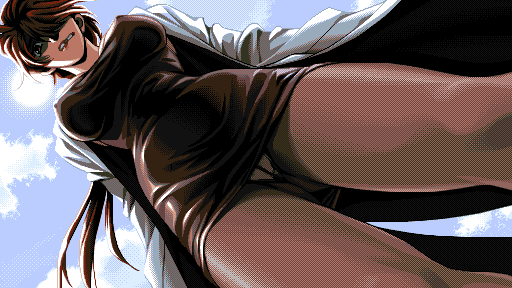
And then...panty shot.
No, I'm sorry, that's not fair. That wasn't the first shot of the game.

This was.
It needs to be stressed here that I knew next to nothing about this game going in. Whatever synopsis I'd gathered from Azuma I'd long since forgotten. Hell, I'd never even played a PC-98 game until then (making me one of the few platform diehards whose gateway game wasn't Touhou.) A certain amount of culture shock was inevitable, and so I immediately found myself plunged ice-cold into an audio-textual-visual environment that was, somehow, both jarringly and bewitchingly alien.
The first thing I noticed was the music.
FM Synthesis is a strange beast. It's not immediately recognizable as
"chiptune"—at least, not in the way that "chiptune," as shorthand for a
style, immediately is. Compared to those mathematically rigid blips and beeps, it's much closer to a real instrument. But it's also...not quite.
Settling in some murky space between the familiar and the real, its waves and
drones are, among the myriad styles of computer music, perhaps the most
distinctly electronic —that is to say, inorganic, even a
little uncanny.
I'd been exposed to FM Synth in some form all my life, though it only began to draw attention to itself when I discovered YouTube gameplay videos, and noticed a telltale difference between NES games and their FDS counterparts, or Genesis games and their arcade counterparts. It was that electronicness that drew me to them then; Because my baseline for what was considered normal technology each console generation was set by the consoles themselves, platforms capable of FM Synth seemed unnaturally advanced, just a bit spooky. And though time—and live audio—had demystified this sound from a technical angle, the spook factor remained, and the PC-98, more advanced even than the Genesis and System 16, was broadcasting live from another planet.
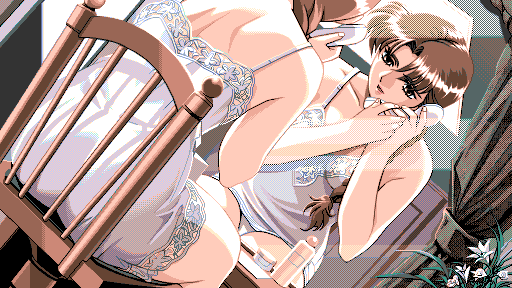
What I saw was as remarkable as what I heard.
At first glance a richly-colored image, closer inspection revealed that its
artist was wrestling with a limited color palette, and worked around it by
dithering the colors to varying degrees, creating countless of shades where there were once only a few. This technique turned what might've been a
technical drawback into an artistic flourish, introducing an eye-catching
play of pixel patterns akin to the ink dots in an old comic book, and
producing colors that were both complex and strikingly sharp, super-slick.
Here were bitmaps that matched the inky gloss of their cel-shaded celluloid
cousins on the TV set and movie screen while maintaining a painter's sense of
shade, texture, lighting and depth.
I took in a lot during those early minutes. You'd think I'd be overwhelmed by the novelty of it all, but what I remember most was an overwhelming sense of deja vu. I remembered other games that dithered like this, other games that droned like this, games I'd played on already ancient computers in a school lab or at a cousin's house, at seven, eight, nine years old. Museum Madness. Number Muncher. Amazon Trail. Strange as it may seem to compare ecchi to edutainment, such games had been my gateway into thoughtful, non-action play, their static backdrops and drop-down menus a cipher for an era of computer gaming I'd since left behind. And so there was something about the format, the style, the pace and even the sense of intellectual curiosity underpinning this foreign game on a computer I'd never touched which, in spite of all else, managed to be, in a distant way, familiar, almost nostalgic, a sobering sensation that suited the melancholy of the song playing over that first encounter, composer Ryu Umemoto's "Movement 1."
And then they started talking.
*opens notes*
I took approximately 100 pages of notes over the course of the game.
This suggests enthusiasm. It flirts with obsession.
It probably is obsession, mind.
Yet my earliest notes were primarily about how grating it was to hear (read:
see) these people talk. I wrote about how the dialogue felt stilted and stiff
in some places, corny and crass in others, how it lacked a sense of healthy
brevity. I didn't know then, and I still don't know now, how much of this
came down to the VNTPW translation (which I am still extremely grateful to
have) or the original script, but I did say "jarringly and bewtitchingly
alien"; this was the jarring part.
And just listen to them go! Here we have our protagonist, Takuya Arima, who is introduced peeking up the school nurse's skirt (that's the panty shot above.) The two of them drag out a deadening exchange; he asks her if she ever goes commando, if she wears her panties as a hat, if she ever sniffs her panties, and so on, and so forth, until she threatens to wipe her shoe on his face. Things let up considerably after that, as he gets up to talk with her at eye level, but you'd be forgiven for turning off the game right there and heading straight to the bathroom to wash your hands of ecchi slime.
It's strange, though, coming back to this scene for reference while writing
this piece, because I don't mind it all as much as I did then. Maybe I've
been desensitized. Maybe having already played this means my expectations are
in check. Now, I don't particularly like it, and you'd still have a
hard time convincing me that Kanno is some genius prose stylist today.
But the facts remain:
- That I would write those hundred pages,
- That I would log over a hundred hours,
- That I would take almost a thousand screenshots,
- That I would eventually write this.
So let's take a step back. Who, exactly, is Takuya Arima?
Takuya is a third-year student at Sakaimachi Academy. His father, eccentric
historian Dr. Koudai Arima, vanished two months ago, now presumed dead in a
tragic accident. He was left in the care of his charming but extremely busy
stepmother, scientist Ayumi Arima. Although he and his father got along like
Mentos and cola while the latter was alive, his sudden disappearance was
devastating; Takuya stopped attending his classes, alienated his friends and
left the kendo club he'd originally been president of. When we meet him at
the beginning of the game, he's skipping his make-up lessons to nap on the
school roof. "I've finally embraced apathy, after all," he thinks
to himself, gazing lazily at the clouds. "If anything, I should consider
myself liberated."
And yet...
Leaning against the railing, Takuya discusses his plans for the future with the nurse, a blunt, messy-haired chain smoker named Eriko Takeda, who doubles as Takuya's ever-exasperated homeroom teacher. They discuss the state of his mother, and the memory of his father. They discuss Eriko's past and Takuya's prospects. And on the way back from school, he is accosted by the usual suspects:
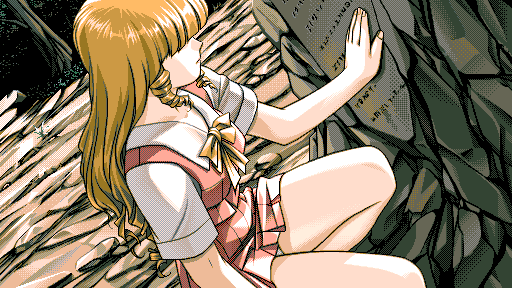
Mio Shimazu - The "school idol" and its most likely valedictorian, in the top 5 for every class. She's proud, high-strung and seems to loathe Takuya, spending her introduction badgering him about attending his classes. Nevertheless, she's an intellectually curious kid, and drawn to mystery; she knows more about the writings of Takuya's father than Takuya does.
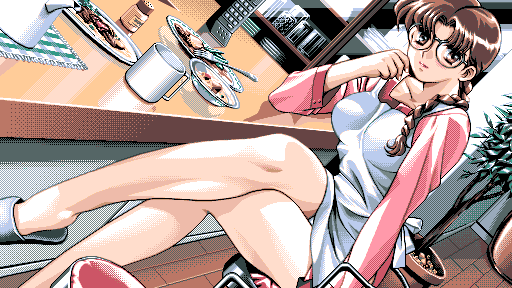
Ayumi Arima - Takuya's impossibly kind, impossibly sweet stepmommy. You know, the type that tends to speak in third person. They're on a first-name basis, though it may be because she's closer to his age than his father's.
Ayumi works at a research institute called Geo Technics.
Ayumi does not talk about her work.
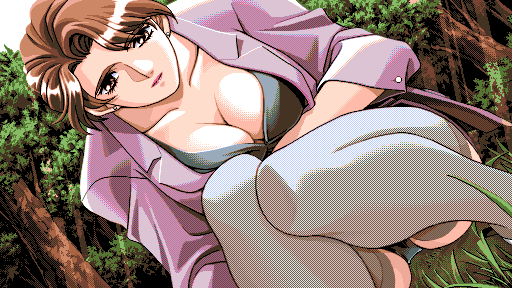
Mitsuki Ichijou - One of Takuya's former teachers, now working as the headmaster's secretary. They talk to each other like longtime friends.
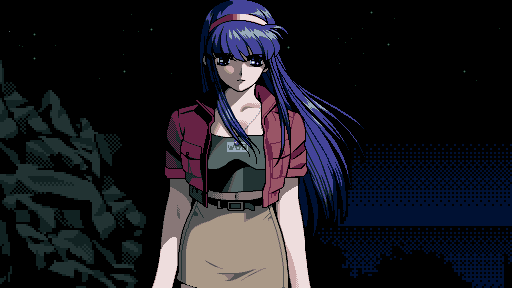
Kanna Hatano - The school's latest transfer student from we're-not-entirely-sure-where, a strikingly solemn blue-haired girl with a soft voice, a dark past, and a conspicuously shiny blue jewel around her neck...
You've probably seen dozens of characters like these before, and the way they interact with you in those initial scenes is extremely played out. You can already hear them, can't you?
"Takuya, you dumb stupid IDIOT!"
"Oopsie-woopsie, Ayumi-kun was just getting out of the shower!! :o"
"Takuya...I'd like to see you in my locker lab after
class."
"Do you mind moving?"
Yes, it all seems just a little bit like a dating sim.
No surprise there; YU-NO is, officially, an eroge, a genre of "erotic games" that dates back to the proto-dating sims of the '80s like Tenshitachi no Gogo and its sequels—and that would, following many evolutions in style and design, contribute to the emergence of the modern visual novel. But don't be fooled: The developers of this game had more in mind than merely getting players off. In particular, according to Sorlie's article, designer and writer Hiroyuki Kanno was intent on pushing the boundaries of the point-and-click novelgame format as far as he could from where he stood. While he took the aesthetic trappings of the dating sim as a starting point, his ultimate goal was to transcend them.
That's Pushing* with an Asterisk...
The HG101 article and Todome's history of the genre (see the link in the sidebar under "Further Reading") both discuss YU-NO exclusively in terms of other eroge, though it's worth pointing out that this game was not an isolated incident; the PC adventure genre was being taken in all kinds of weird new directions during the mid-'90s, from other Japanese games like Cosmology of Kyoto and Eastern Mind: The Lost Souls of Tong Nou to games overseas such as Myst and Phantasmagoria, whose heady mix of eroticism and supernatural horror offers clear parallels to its Japanese cousin. In this sense, YU-NO fits in very nicely with its era (though Kanno was most likely oblivious to these developments at the time.) Even its central conceit could be seen as a matter of Steam Engine Time; this was the same era when scholars such as Janet Murray and Espen Aarseth were pondering the possibilities multicursal, hypertemporal narratives held for all forms of interactive art.
Furthermore, while YU-NO's influence on later visual novels is easy to spot (Steins;Gate, anyone?) calling it "revolutionary" in terms of vision or scope is fundamentally misguided. It only appears as such when compared to those games in its immediate orbit, other dating sims and eroge popular at the time. By framing its accomplishments within this narrow context, the game is mischaracterized as a big fish in a small pond. It's a distorted lens, pointing only to those games we can point to and retroactively connect to the concept of a visual novel as we understand it today. I say "retroactively" because the term "visual novel" had just barely emerged in 1996, and did not exist at all beforehand. In fact, it has even been observed that the term "visual novel" is used differently in English-speaking regions than in Japan, to refer to a delineation that, in Japan, doesn't actually exist.
In reality, YU-NO shares as much generic kinship with games like Policenauts, Makyouden and Metal Slader Glory as it does with dating sims of any kind, games whose formal ambitions were already on par with YU-NO's years before it existed. This isn't a put-down in the slightest; rather, it's an invitation to appreciate the game in a new way, as part of a varied and vibrant family of Japanese graphical adventure games, the lineage of Portopia, Snatcher and Dezeni Land, a family it isn't often placed in due to its established place in VN and eroge fan circles, but one that it rightfully belongs to nonetheless.
Thus, while the game starts off simply enough, there are hints of something strange and sinister lurking below the surface. Koumitsu Ryuuzouji, headmaster of the academy and a fond colleague of your father's, shows an acute interest in the fruit of the late scholar's research, asking you and your mother if he'd left anything peculiar behind, and offering to "inherit" everything in his study, from cabinet to clock. There's talk of a curse surrounding an old mansion by the school, where a man was recently found with his head and limbs ripped off. And there have been reports of freak lightning striking out of the blue sky over Geo Technics' digging operations on the nearby beach. Perhaps the last of these is why folks from the company have been calling your house, with some pointed questions for your mom.
At first, these incidents remain in the background, squeezed briefly in-between bad puns and "colorful" flavor text. But gradually, they accumulate, their significance dawning on our hero-to-be as he thinks over the events of the day. Whether this contrast of moods was intentional or not (and it was most likely not,) it plants quietly in the mind the idea that the breezy, balmy surface you are presented belies a hidden tension, its tranquility a deception, and is not to be trusted.
Especially once the package arrives.
Takuya first learns about the package from Ayumi, whom he runs into on his way back from school, a day after the game begins. She tells him that a large parcel has arrived at their house, addressed to him, but with no return address. True to character, he figures it just has to be those porno tapes he'd been expecting. He rushes home, where the package is waiting in his room.
And now, at last, we reach the first big twist of the game:
Expecting to kick off the summer with lewdie nudie-movies, Takuya is instead
hit with a dose of reality...
...Though of which reality, it is not immediately clear.
Inside the package are the objects pictured at the top of this page. You can scroll up if you like. The first is a mirror. The second, an unidentifiable object whose "texture is like that of a seashell," smooth under his fingers.
The third is a letter.
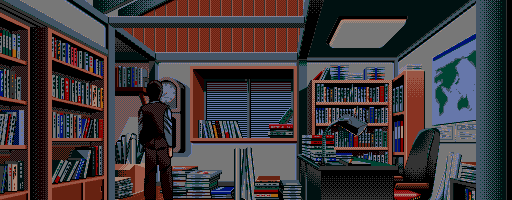
Guess who it's from.
"Have you ever pondered the very definition of history, Takuya?" Koudai begins. He admits that in the past, he thought of the subject in much the same way as anyone else: Past becomes present. Present becomes future. One moment connected to one moment more. End of story.
Or is it? "Let us entertain another idea," he continues. "What if there were multiple paths in which the past could form the present." His thesis is thus: That time is neither unidirectional nor unilinear. Having discovered this, he says, he now has to leave. He doesn't say where. He doesn't say for how long. But he assures Takuya this: that he is not dead, and that he will explain everything in time.
The mirror, we learn, belonged to Takuya's birth mother, Keiko, the blonde woman from the opening shot. The other object is an artifact than can alter the flow of time. "That stand-alone has but enough energy to reverse time within an interval of a few dozen hours at best...the real system is elsewhere." Finally, the letter instructs Takuya to go down to Triangle Mountain at 10:00 tonight, where someone will be waiting for him, to whom he must deliver the artifact. "Make sure that the eight Jewels are inserted within..." the letter says, and the truth will be revealed.
Problem is, there are only two jewels in sight.
Unfortunately, there's no time to search. The appointed hour is less than an hour away. Takuya strikes out into the chilly night air, finds his way to the base of the mountain...and waits.
He waits for a long time. He calls out and gets no response. He isn't sure what to expect. Maybe the person waiting for him is his father. Maybe this is just a prank. By this point, it's past ten.
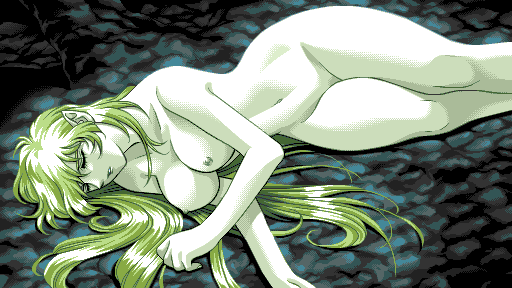
Then, he hears a faint voice coming from around the corner. He follows it to the other side of the mountain, where he finds a blonde woman, naked, lying unconscious on the rocks. She slowly comes to and, upon seeing Takuya, bursts into tears and kisses him on the lips. She's smiling now. "It's as if she's just returned home from a long journey," Takuya thinks. Then she struggles to speak, then she slumps back to the ground, then she finally dies.
And the woman vanishes into thin air, leaving Takuya alone.
He wonders aloud what just happened. Ryuuzouji responds.
"I see... I suppose she has been cast off into the flow of causality."
Takuya turns to face him. Ayumi is there, too. She looks confused. Ryuuzouji
looks disconcertingly not so. He demands the mirror and the artifact.
When Takuya refuses, Ryuuzouji pulls out a gun.
But before he can shoot, there's a rumble and a flash of light. His voice becomes faint; a high-pitched humming rises to the fore. A figure comes into view from a rock in the distance, watching the three of them. A face with blue hair, a red headband, and no expression.
It's Kanna. Takuya blacks out.
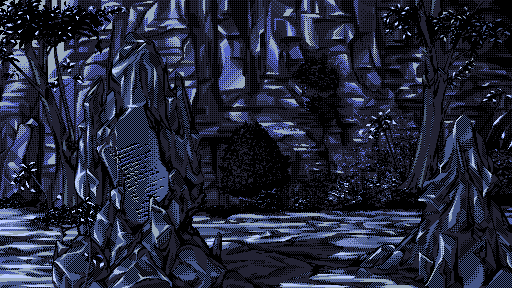
Where...am I?
...My head hurts...
My cheeks hurt...
...They prickle...
He wakes up at the base of the mountain. He hasn't moved. It's still night. It's unclear how much time has passed. But he still has the artifact, and Ryuuzouji is nowhere to be seen. Without realizing it, Takuya has just jumped into an alternate timeline.
In a matter of minutes, YU-NO had become something very different.
My impressions of the scene, as taken from my notes, were thus:
"Often, the nicest thing I can say about a game I think is far from perfect is
that 'I can see why people liked it so much,' assuming I find those reasons
sympathetic. I can see why people like this one so much, and I have every
intention of seeing it through to the end. I have a feeling that it's only
going to get better from here. (May, 25th, 2017, 4:46 PM.)"
All of this was the prologue. Now the game begins.
May 23rd, 2017
So, here's the situation. The artifact you're carrying is a time-travel device called the Reflector. Time is a river, splitting off into ever narrower streams, and the Reflector is your rudder, letting you snap backwards and forwards, from one branch to the next. Somewhere in this web of intersecting, interlocking spacetime, Koudai Arima is waiting for you. As Takuya, you take it upon yourself to find him, solve the mystery of his disappearance, and unravel the great big ball of timey-wimey stuff that you, Ayumi, Eriko, and the rest of your friends are tied up in. But beware: None of them are quite who they seem.
There's a break in my notes here. When they pick up again, I'm midway through one of the game's main routes. At this point, I could continue the dramatic synopsis I've been giving for the last thousand words or so, but instead I'd like to switch gears and discuss the gameplay.
YU-NO is a point-and-click, first-person graphical adventure game. The plot branches off based on your actions, and there are many endings, both good and bad. Making progress requires you to manage items, solve puzzles, and keep track of characters' schedules, which remain consistent between timelines. But most of all, you'll have to take advantage of the time-travel tools given to you by your parents.
When you click on one of the jewels embedded in Koudai's Reflector, it disappears and your position in branching time is marked on a map of all the routes you've taken so far. Then, whenever you want to go back to that point, you just open the map, click your Jewel-Save, and you're there in the blink of an eye, your Jewel returned for future use. From there, you can take a different path through the story. There are other jewels scattered across the various timelines, and the more you have, the easier it is to back-track and experiment.
Meanwhile, Keiko's mirror binds you to the Shrine at Triangle Mountain, returning you there at the end of every route so you can try a new one. This doesn't truly reset the game, though, as any items and jewels you've collected are carried over into future loops. Recursion in time is central to the game; you'll often need an item obtained in one route to solve a puzzle in another.
So: Jump, loop, link, find items, talk to people, see endings. We've got the gist of the system down. And with this established, you're ready to learn about the real magic of this game. It's time to talk about time.
A Brief Section on Videogame Time
Time in videogames is idiosyncratic. It jumps forward and skips backward, branching and looping at will. You die and repeat a stage. You win and replay on hard mode. You reset, over and over, perfecting a run. You use a password to read ahead to your last save. All of this is considered normal, natural.
And in a sense it all is, an inevitable consequence of a medium tied intimately to the computer. Every event in a computer program has an address in a linear progression of code. A game which only followed this sequence forwards could only ever present a single sequence of events, like a song played on cassette. To animate the laterally expanding playfields and non-linear stories typical of the form, it is necessary to occasionally hit Fast-Forward or Rewind.
The program marches inexorably onward, from one instruction to the next, like a wave. To play the program like a game is to ride this wave, to plug your input into the maze as a new passageway through which its execution flows, now altered, the key changing shape to accomodate a different lock and move down a new path, in a succession of dice rolls and conditional combinatorial logic that recalls the Lottery of Babylon. "In reality, the number of drawings is infinite. No decision is final; all branch into others." Jump if equal. Branch if less than.
In this way you can break the sequence, push against the wave with a backwards long jump or an out-of-bounds shinespark. You produce an unexpected iteration, an element of chaos the game corrects by snapping to the closest safe position.
Occasionally, a game will show its hand. You'll find a Warp Zone that sends you backwards. You'll find a Kid Chameleon, whose vast web of teleporters and lack of a familiar world-level structure slowly scrambles your internal compass, producing the impression of a game that extends into the horizon forever, with you powerless to anything but stumble through, from one faint light to the next. You'll find an Atlantis no Nazo, where the door at the end of the level is as likely to point backwards as forwards, or to trap you in a Hellish infinite loop, where accessing levels out of sequence is not only condoned but encouraged, and planning your ideal route is half the game. Or you'll find an Umihara Kawase, in which the time it takes for you to swing through its surreal, checkerboard vaporwave jungle gyms is much an indicator of where you'll end up next as which door you go through. Not moving is also an input.
These games aren't really strange, just honest. They show you that the sense of spatial coherence off which you build your mental maps—and which powers the Metroidvania or the open-world sandbox—is a trick, a sleight of hand. The sense of space, of a "world" generated by the videogame, is an illusion resulting from the bending of time, from the abilty to repeat a core loop over indefinite iterations and across infinite varaiations, a condition necessitated by the material reality of even the most "linear" game. Links and recursion are its primitives. Update(). Render(). Die, reset, retry. It's no wonder that time travel is such an evergreen mechanic, from Sonic CD to Braid to Majora's Mask to Chrono Trigger...and finally, to Takuya and his Time Stones.
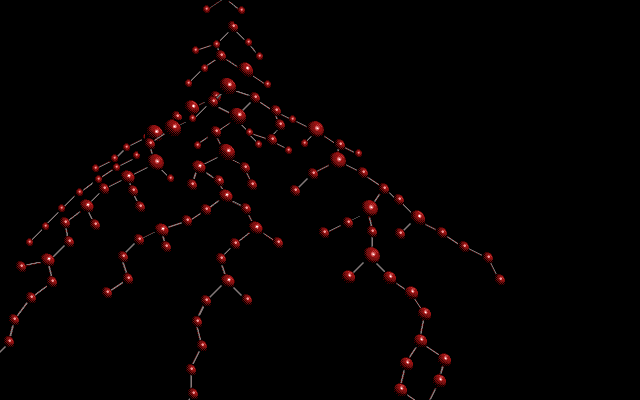
A videogame is a labyrinth in time. YU-NO presents us with the clearest and most compelling metaphor for this concept ever conceived.
This snuck up on me. I was midway through one of the game's main routes when it did.
Mio/Babel
Here's the short version:
The morning after the start of the main game, I ran into Mio at the base of
Triangle Mountain, trying to decipher the etchings carved into its stone
slate. She forgot her notebook upon leaving; in trying to return it, I found
myself getting dragged into the investigation. Some hijinks later, I was
walking her home when she realized she'd left one of the books she'd been using
in her research at school. I volunteered to run back for it, and we agreed to
meet at a nearby cafe. This is where I was now, trying to spot her and asking
the other patrons if they'd seen someone matching her description.
I stopped for a moment to look at my map, trying to work out how far along I was in the story. And it was upon seeing the map that it hit me.
Most people who play YU-NO will go into it knowing that its plot branches out. What they don't always tell you is how much. The path I'd charted through what I'd thought was a fairly straightforward series of events was in fact full of twists and turns I hadn't noticed I'd been taking, a jagged line bending at right angles and forking at several points, with a stub of a line to represent a path I could've taken and could always go back for. This was A.D.M.S., an "Auto-Diverge Map System" adapted from the automapping feature already being used in dungeon-crawlers at the time. (The PC-98 had no shortage of dungeon crawlers to draw from, but that's a story for another day.) It was a dizzying sight, as you can imagine. But more importantly, it brought to the surface an idea that had been incubating in my mind up to that point.
Over the last year, I'd become interested in the concept of the "possibility space" in game design, a term used to describe how the range of possible strategies and playstyles expands and contracts as a result of a game's rules, however simple or complex. (Go, for instance, is a board game with a rather large possibility space.) I'd taken the position that the meaningful possibility space of every videogame was finite, and would eventually be exhausted if a game was played thoroughly enough, whether that took an individual or a community:
"...if every action game is a puzzle where you have to find an optimal route,
and if in all of these games, the layout of the world is fixed,
and its denizens move in fixed patterns,
then it follows that every game has an optimal route,
even 'non-linear' ones,
even the ones that seem infinite and open-ended.
We've already torn Donkey Kong apart,
Hit a perfect game of Pac-Man.
Super Smash Bros. Melee is next, eventually.
And don't even get me started on Tetris."
Had I been writing this now, I might also add that Koudai Arima wasn't the only
one with a few words to say about jumping into parallel universes.
But I digress.
You'd be forgiven for finding my analysis bleak: That every game has a "20XX" on the horizon. But in fact, it was formulated in response to what I thought was an even bleaker outlook: That a game had to provide a certain amount of playtime and content to be worth its asking price, a minimum that was often unreasonable. It was the idea that, for instance, a $60 game that offered "only" 50 hours of gameplay was somehow too short to be worth the trouble, as though the value of a game was directly tied to the amount of stuff you could wring out of it, rather than whether any of those 100+ hours were worth looking back on after the fact.
While this side of the issue was consumerist in origin, the other side of it was the very old idea, still held by some, that the ideal form of interactive art was a computer program capable of generating an infinite number of stories. Such an idea is tantalizing to think about, but it has the undesirable effect of framing the finite games that already exist as inferior versions of a platonic ideal which had yet to exist. Everything with a single ending is merely prologue.
In both cases, it all came down to the same complaint: that these systems were just too darn closed. It's a problem similar to the one outlined by Christopher Goetz in "Stepping Out of the Virtual World Paradigm": In the shadow of an imagined VR supermedium, "games can only be made sense of as failed virtual worlds." Thus, I countered that not only were all possibility spaces finite, but that this was fundamentally *good*, that it was from the shape of the boundaries of that space that the personality of a system became apparent, and that a game which tried to encompass everything ran the risk of becoming so muddled and incoherent as to say nothing at all. The beauty and joy of play, then, was making out the shape of that thing, of uncovering the lines and walls and marveling at the complete image of the space.
You might be wondering, a couple hundred words in, what any of this gibberish has to do with YU-NO. But here it all was! Here was that idea literalized through my map! The possibility space was a space! The labyrinth in time was a labyrinth! From my journal:
"...a while ago I talked about how videogames were animated databases that produced fundamentally bounded possibility spaces. And while I've long since made peace with that fact, it's a bit weird to see it so transparently thrust in your face, for a game to not only recognize itself as a bounded database, but to go so far as show where you are in it, and as if that weren’t enough, to trace the path you took through it. Both the ultimate immutability of this space and the freedom to travel through it as you please are explicit details of the plot; just swap out "history" for "videogames."
"This makes YU-NO very interesting, downright fascinating, as a videogame about the nature of playing videogames."
I smiled faintly, thunderstruck.
This, in hindsight, was the moment that would seal my fate. From there, the
game had a way of sinking its tendrils into me, in way that felt deeply
personal. The climax of the route brought us to a complex of tunnels hidden
under Triangle Mountain, and from there the rabbit hole went only deeper,
darker, into a web of riddles, ancient tongues, visions, love and horror and
above all, mystery. It reached out and grabbed at a primitive part of my
imagination, which had been weaned on the strange, on morbid folk tales and
Spooksville books and tattered back issues of Asimov's Digest; on stories of
the Bermuda Triangle and the Atlanteans and the Hereafter; on the odd things I
found on my parents' shelves, books for adults I read as a child, with titles
like
I was over the moon. My eyes were full of stars.
Like Breakout to Sudnow, this, I was certain, was my game.
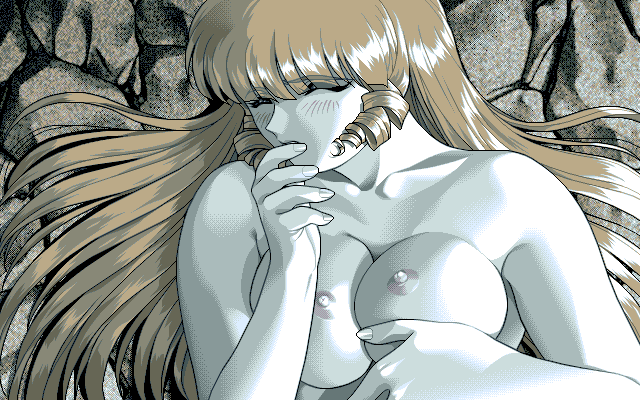
...And then, H-Scene.
Beyond that, though, it just felt...perfunctory, like the vestigal limb of a mode of engagement at odds with what the game looked like it was evolving into, a reward I'd never asked for. "I'd always operated under the assumption that getting to know who [Mio] really was would be its own reward," I'd write later. I turned back to Sorlie's retrospective, scratching my head. It read that at the time, the visual novel was undergoing a slow growth away from straightforward pornography into something else, and that YU-NO was apparently critical to this process. (In the time since, I've learned that the truth is a bit more complicated; I'll return to this later.)
I looked back at the game. Apparently, there was a still a ways to go.
This would begin a pattern, an emotional rollercoaster that would persist throughout my playthroughs, in which I'd ride the wave of the game's atmosphere and design, ecstatic, before being brought crashing to Earth by something equal parts lewd and ridiculous, before being swept off my feet again and feeling a little miffed that the game just wouldn't let me hate it.
In truth, the lopsided rockiness of the experience, its hentai weirdness, was probably part of what attached me to it, the same way some people might imprint on a game with wonky collision detection, or where you die after falling a one-block gap, or where all the enemies are palette swaps of the same sprite and the music is an 8-bit rendition of All Kinds of Everything, which they definitely did not get the rights for.
It was a horny mess. But it was my horny mess.
I wanted to believe it could fly.
Like stew sprinkled with flour, the plot thickened.
I learned that Kanna-chan lived alone in a sterile, dilapidated apartment, and
had some connection to your father. I learned that Takuya and Mio had been
on much better terms before the game had begun, and I learned from Mitsuki that
the headmaster had been very strangely since your father's disappearance,
emptying his room of all possessions and sleeping on the floor to start. I
learned that the construction director For Geo Technics had been responsible
for the accidents—and that Ayumi was getting the blame. Between all of
this slipped a woman named Kaori Asakura, ostensibly a reporter, dry and
unpredictable, who already seemed to know more than she let on. Everyone did.
Partway through Kanna's route, she speaks to this sense of vague unease:
【Kanna】 Our lives are built upon a hidden tension
that is being balanced by the deception of tranquility.
In terms of characterization, this is a very "Kanna" thing to say, but it applies as much to the state of Sakaimachi as it does to a worldview shaped by isolation and trauma. And beyond that, she might as well be describing the game itself; I opened the map just after she said this, its tangled latticework overlaying the quiet park where we were having our conversation.
Layers under layers. Let's run with this. Azuma characterizes YU-NO as a game that collapses the over-layer of the story and the under-layer of the game system into a single plane:
"The player of novel games such as TheScar andAir obediently accepts individual dramas that the game system generates. The analysis of the background structure, extracting story lines and images, and the network of exchanging information and derivative works—these activities all reside outside of the game play[...]In novel games, the drama is visible while the system that generates it is not; butYu-No gives the illusion that both are visible."
To elaborate: In the typical "novel game," as he called them in 2001, there is the narrative, and there is a system underlying the narrative, a database of character and music files which is only assembled into a "story" at runtime, animated by code. I used the term "animated database" to describe this phenomenon at the time, and although Azuma's interest leaned heavily towards visual novels, this type of granular organization is present in most games to some degree. Retro games are an especially instructive example, as the graphics-crunching PPUs (Picture-Processing Units) of early Nintendo machines were practically built on this principle; just swap "tiles" for "files" or, specifically, "image files" for "character data."
Character Data?
"Character data" here refers to the tile-based graphical data stored in ROM banks on cartridges like those used with the Genesis, NES and MSX. It's a turn of phrase that goes back to early computers, which stored in similar fashion letters, numbers, and miscellaneous symbols. That is, characters. In this sense, you could argue that the tileset you rearrange to assemble your graphical world is your "alphabet," and that assembling graphics in this way is not fundamentally different from creating ASCII art. ;-)
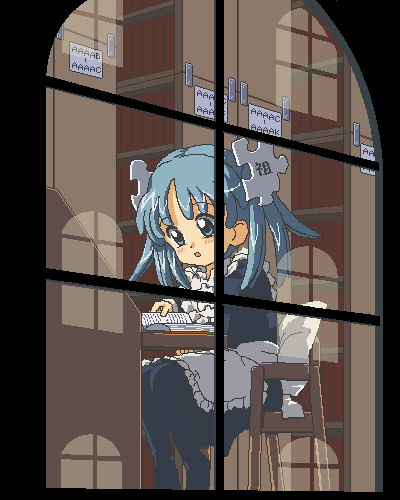
Consider the example of the Library of Babel.
A library whose books contain all possible combinations of a preset alphabet,
it exists as an infinite sea of garbage and noise. But as a result of the fact
that all permutations of a book using this alphabet are in theory somewhere in
the Library, it is not uncommon to find coherent or semi-coherent works, and
it is hypothesized that somewhere in the Library is a perfect book, as perfect
a book as possible within the contraints given by the format shared by all the
books in the library, its alphabet, page length, book length, and so on. Many
have spent their whole lives trying to find this book, though none have found
it.
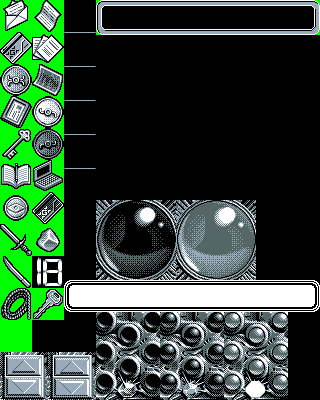
Character Data is analogous to this; from its fixed visual alphabet countless frames can be generated, under the guidance of algorithms designed to keep them in harmony. Beautiful games are those in which the sprites, the individual visual elements that are used to construct these frames, are harmonious in color and style, in which they fit naturally together, even when they are assembled in a way the designer of the game could not have forseen. This is admittedly easier in the case of a game like YU-NO, where every character portrait is its own file, than in a game whose graphics are built out of 8x8-pixel units, but it is critical no matter what the scenario.
If one possible metric of videogame beauty, then, is how easily a game's objects, its tiles, its visual possibility space lends itself to beautiful images, you are really trying to determine the distance from any position in the library to a perfect Babelian book. As a designer, the questions to consider are: What kind of library will you construct, and what is the alphabet you will use to construct it?
...Of course, the point here is that the relationship of character data to a game's visual possibility space is itself just an analogy for the relationship of a game's files and code to its total possibility space. This data is simultaneously "the gameworld, deconstructed" and "the gameworld, compressed." While we're used to talking about compression in terms of text or audio or video, it's not a massive leap to go from there to entire gameworlds when we're talking about videogames. An LZ77-compressed text file is essentially a series of objects and the instructions on how to assemble them into a complete novel. Likewise, a Famicom cartridge contains character data and functions, and instructions on how to assemble them into all possible playthroughs.
It's possible to think of a videogame cartridge as a kind of world compression, essentially no more than the patterns and the instructions to reconstruct a world through them. Though you could make the argument that universe compression techniques are necessarily lossy, you can learn a lot about the character of the resulting approximation from what is left, what is emphasized, and the size and shape of the gaps.
In presenting this, in holding up a mirror to the secret machinery of ergodic narrative, one might worry that the game risks exposing its own artificiality, and thus breaking its own illusion. But in fact, the map suggests an underlying reality more rich and dynamic than actually exists. YU-NO is, fundamentally, a series of scripted events connected by a decision tree, as I'd note while marking down which braches I had and hadn't taken halfway through the game: "This being a point-and-click adventure, the behavior of the characters isn't systemically determined, and thus is not capable of being truly emergent." Despite this, it manages to fake a sense of organicness that can be used as a compass to guide yourself through the maze.
Funnily enough, it wasn't YU-NO itself that helped me understand how this illusion was maintained, but another game I'd been playing at the same time, and one with a substantially more robust simulation: Nintendo's The Legend of Zelda: Breath of the Wild. Specifically, the game's "cooking" mechanic, in which any sense of "simulation" comes down like cardboard under closer examination:
"Although it feels like you can combine ingredients in an infinite number of ways, there's actually a finite number of recipes available, and the logic by which a set of ingredients equals a recipe is not "natural" but pre-ordained. Yes, you can swap out mushrooms for carrots and turn you mushroom risotto into a veggie risotto, but the only reason it works that way is because a designer chose that result in advance. The computer would [not] know what to do by itself. The reason this process feels natural is partly because there are so many possible combinations, covering seemingly every basic case (I've discovered about a hundred or so, maybe more, I don't remember,) but also because every combination you can think of that doesn't produce a new recipe (and isn't the sort of dubious food you get by mixing food and monster guts) snaps back to an existing one based on a predictable (if somewhat strange) logic (no, seriously, 'Mighty Milk' and 'Spicy Spiced Meat Skewer' are hilariously broken results.)[...]
"This is in much the same way that almost every action you take in YU-NO seems to take you in the right direction down someone's route." <2253.16.04.2018
As a result, I rarely wound up getting stuck, in the sense that I was unable to progress, which is impressive when you consider the sheer mass of puzzles involved. In terms of proportion, few of these are the kinds of puzzles you'd traditionally expect from the genre, as your repertoire of items is relatively small, your range of actions limited and context-sensitive. While there are a few spurts of pixel hunting here and there, a tricky game of Picross in Mio's route, and an absolutely hair-raising visiual riddle at the climax of the main game, the real puzzle, for the most part, is just playing the game, surfing the story web, gaming its countless divergence points to shunt Takuya down the track toward the ending you want, through a system so transparent that you don't realize it's a puzzle at all except in hindsight.
Comparisons can be made here to action games like Starfox 64 and Cave Story, in which the plot branches off and the choices involved aren't presented to you in the form of an obvious menu but as the accumulation of all kinds of small actions, like skipping a dialogue event, revisiting an early area of the game, or flying through stone rings to impress a fellow pilot. While there is usually an ending-critical decision for every route in YU-NO (usually accompanied by a sinister musical cue—trust me, you'll know it when you hear it,) the crux of the game is that anything you do could potentially be significant.
But what makes this a "puzzle," exactly? A good puzzle is not so much one where
the process of solving it is difficult, but one whose solution reveals
something meaningful about the environment the game is being played in,
something which causes you to see that environment in a new light.
"Environment" is deliberately vague here; that revelation can be about your
avatar, like learning you can dash and wall jump in Super Metroid, or about
the very setup you're using to play the game, like the "Find Home!" puzzle in
the original version of Snatcher, in which you refer to a cryptic note while
trying to log on to a computer whose password is a single key. ("Home," we
discover, refers to
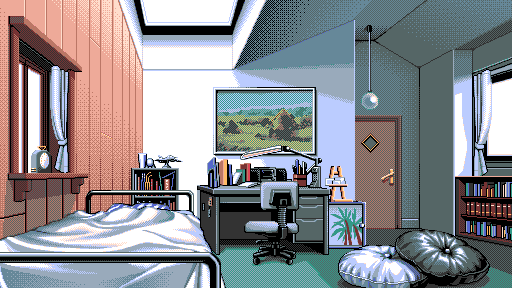
In the case of YU-NO, the revelation is about character. Because the characters follow known schedules, you can predict where you might find them in a new route if you pay attention to what they've been doing and talking about in an old one, and even meet up with them without any prompting from the game. While tricks like these are great for pinning down new divergence points, they can also give you a window into the private lives of the game's cast and the larger story, Like when you find out where a character who mysteriously vanished during one route was hiding all along (and in Ayumi's case, with whom,) or meet up with that student staring at the school bulletin board who gives you a different hint on every route. It's a masterful riddle that breathes a sense of bubbling life into a static backdrop, giving the impression of a world that persists beyond and without you. You could arrange these scattered glimpses into a coherent timeline if you wanted, minus your own interference. It is top-class adventure game design, worth an analysis all its own. But let's keep moving.
The parallels between YU-NO and Cave Story are illustrative in another, more
subtle way: both are games in which, sometimes, the weight of the choices you
make isn't about the decisions themselves but about the costs of sticking to
them. Realizing you can make a better ending for
In fact, sometimes the stakes follow you home.
We never did get out of that maze. We had uncovered a monolith of ancient technology, a lightning machine, just as it was springing back to life. Sparks were flying. The noise was unbearable. The mountain was crumbling apart; we'd be crushed under the rocks if we didn't escape soon. Brought here by a strange, ghostly figure, by the very spectral waif who appeared to Dr. Arima the night he disappeared, we found an exit, a door to a tunnel. We could see daylight breaking on the other side.
Unfortunately, the light at the end of the tunnel was a train.
Or in this case, a gate.
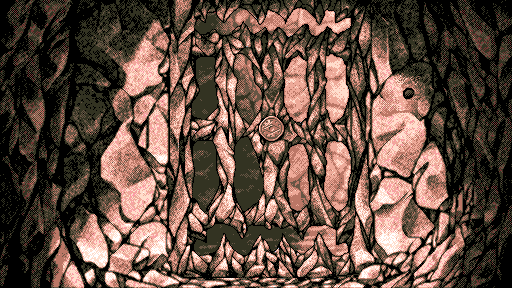
One last gate. We'd worked so hard to crawl out of this earthen hole, searched to the point of exhaustion for a backdoor or a trapdoor or a hidden passageway. I spent hours, in real time, trying to solve the riddle of an old sarcophagus. Freaking nonograms, man. I took *notes*. All to be cut off at the last minute by unbreakable bars over an uncrossable threshold.
There were few moves remaining. All I could do was remove the stone disk in the center of the gate, which produced nothing but a slightly expanded inventory. I clicked around furiously, panicked. A warning from Takuya: Now would be a good time to leave a Jewel-Save. The crystal on the Reflector had lit up. A divergence of route-ending severity was immenent.
Suddenly, a thought. A tiny, insignificant thought, but...
My clicking slowed. Not from despair or frustration, but distraction. Curiosity. I'd noticed something odd.
What was that hole in the wall? What was that circular depression, that tiny thing I could fit my thumb into, and where had I seen it before? Yes, that was right. I'd seen it before. I'd seen a gate just like this before, when I'd come down here with Mitsuki to find Mio in the first place. I'd found a pair of little coins, and slipped them into slots like this one, raising the gate...before it came back down between us, leaving Mitsuki behind and me alone. But I was out of coins, and from there it became painfully clear what was going on.
I'd missed something.
I'd missed something, and I had to go back.
I had a hunch what to go back for, and where. You see, we were currently standing at the bottom of the dry well in Ryuuzouji's courtyard. I knew we were at the bottom of a well because the camera had graciously zoomed out to show us a moment before—Kanna was waiting for us at the top. And I knew that we were at the bottom of his well, because I'd seen it before—from the outside.
YU-NO's attract mode demo, which plays immediately after the intro if the player does nothing, sees Takuya in front of a worn-down shed in the middle of Ryuuzouji's courtyard. After sneaking inside and looking around, he turns down an impossibly long, winding forest path, and is asking himself why someone would have an impossibly long, winding forest path in their yard anyway...when he sees a dry well in a clearing up ahead. Mituski mentioned seeing something glittering in the wall of the well the other day, and there it is now, glittering and just out of reach. He heads back to the shed and turns his attention to something he'd ignored the first time around: a rope hanging on the wall. Taking it to the tune of a delightful Item Get chime, a plan begins to form in his mind.
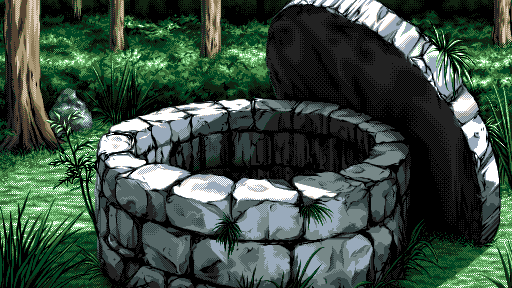
Whatever I was looking for was in that well. I'd played through this scene earlier in the route, but missed my opportunity to snag it. All I had to do, then, was repeat my actions up to that point and remember to take the rope before Ryuuzouji came back home (the darndest thing, I wasn't exactly "authorized" to be there...) I hated to leave poor Mio at the altar after everything we'd been through, but I assured myself that this wasn't a fork in the road, just a detour. "Make no mistake: Once I have that silver medal, I'm outta here."
"Mio," I said, "I promise I'll come back for you." And then I was gone.
...And that was about the point where things got screwy.
My plan had been to slip in quickly and slip out quietly, without making a mess. But I turned right where I should've turned left, and found to my horror that I'd diverged from my original route within minutes of restarting the game. I was lost in time. Some events were familiar. Most were not. I looked at Mio like I'd seen a ghost. And all the while, something new and disturbing was hanging over the proceedings, like a thick fog. Layered over the narrative was a metanarrative of a traveller adrift in an ocean of cause and effect, trapped in a web of his own making, floating like a spectre from one link on the causal chain, trying to find a way back to his own time...and to the promise he made to another girl in another world. This had become Takuya's story.
...But is it really a metanarrative if leaving the Jewel-Save was Takuya's idea in the first place?
Good question. In one section of
"Time in videogames is is plural and multiple—defined as much by what did not happen or could've happened or happened but was then overwritten by what actually happened. Jayemanne suggests an ultimate nonlinearity of videogame time, of its habit not just to progress ever forward but to ebb and flow rhythmically and to turn in on itself. Through character deaths, saved files checkpoints action replays, Let's Play videos, walkthroughs, skippable cutscenes, lag, fluctuating framerates, and countless other phenomena, time travel is a banal feature of videogame play."
Bolding mine; I squealed in delight when I read this.
The fundamental achievement of YU-NO is that it collapses the synchronous and diachronous layers of videogame time into a single narrative, that it blurs and often outright erases the line between narrative and metanarrative. You may have played games like this before, recently even, but remember that this was before Undertale, Pony Island or Doki-Doki Literature Club, before Kimi to Kanojo to Kanojo to Koi, before Metal Gear Solid and Psycho Mantis. To play it in 1996 would be revelation; to play it today is still uncanny.
My map reminded me of a grid of train lines; managing divergences was like catching trains. As I transfered from one branch to the next, over and over again, learning to surf the lines of my map, these moments in time began to feel like physical things I could reach out and touch. I had recently seen the second Urusei Yatsura film, Mamoru Oshii's Beautiful Dreamer, which begins with a group of highschoolers, their parents, and their eternally-sardonic nurse all stuck in a sinister Groundhog Day loop, in a town as eerily empty and plastic as Sakaimachi began to feel after I could see the crystalline walls of its temporal shell, like an island floating in the void, somewhere between a sandbox and a cage. It's a shame what became of Kanno; I'll never be able to ask him if he'd seen it.
Mitsuki
I eventually found my silver coin. I went back immediately to help Mio.
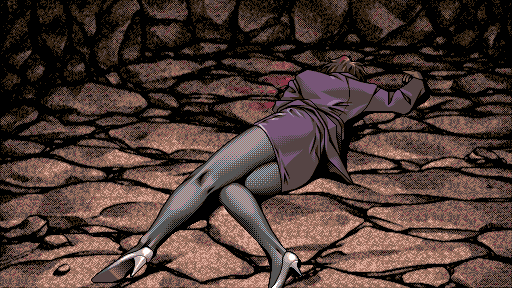
In the process, I inadvertently got Mitsuki killed.
I began to feel like I was spinning plates.
"Time as cage" is not an irrelevant observation, nor is "bounded possibility space." YU-NO is a game about fixed boundaries, about immutability. Specifically, it is about fate.
It becomes increasingly apparent that time is not within Takuya's control, nor mine, and being able to travel through time does disturbingly little to mitigate this. Mitsuki died after the gate to the inner cave closed between us; unable to open it back up, she fell down a hidden pitfall trying to run back for help. Realizing that she can't die if she isn't in the cave in the first place, I decided to take Takuya's guy friend Yuuki instead...only to have him fall down a pit and die, too.
I only find her dead when I go back into the cave after helping Mio up the well, so perhaps if I take the opposite choice and go up the well with Mio, something will change, right?
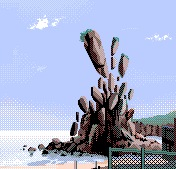
Wrong. The mountain collapses, burying Mitsuki with it.
In my frustration, I step away from this plot thread altogether and focus on
solving the problems in Mitsuki's life, taking me onto another route entirely.
Together, we dive into the curse lingering around Ryuuzouji's estate, and the
story takes a turn into creeping horror. The headmaster himself is implicated
as the source of the curse. There are signs that the man living in his house,
with his clothes, his family, his voice and his face, may not be him at all.
When Eriko and I question him in his shed, he pulls out a familiar-looking
gun.
And this time, he fires.
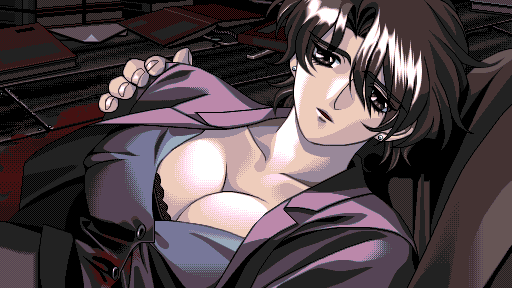
Mitsuki takes the bullet. God damnit.
At this point, I'm beginning to panic. I rack my brain for some clue, some critical detail I'd missed...and remember the stone disk I pulled out of the gate at the dry well's tunnel-side entrance.
Finally, it clicked. I understood how to save everyone. I played Mio's route like normal, brought Mitsuki with me into the cave. But this time, I took a second look at the gate to the inner cave, the gate that had closed between Mitsuki and I the first time around. This gate had a circular depression in its center, just the right size for my disk. I instered it, I went under...and like a miracle, it held. Mitsuki and I crossed over threshold to explore the rest of the cave. We found Mio together.
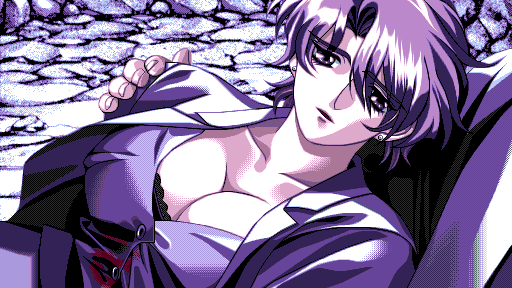
...And then she got zapped by a bolt from the machine under the mountain. OooOo0oPs!1!!
This, my friend, is what it's like to play YU-NO. Takuya stumbles from one catastrophe to the next, pitted against foes whose strength and savviness far outmatch his own: yakuza with hearts (and muscles) of stone, shrewd spies specializing in subterfuge and cunning corporate saboteurs, monstrous dopplegangers with supernatural powers of suggestion—and hypnotized drones with bloodlust where their pupils should be. Victories are rare, difficult, and often ambiguous; if he is fated to disappear once his 50 hours are up, is all the work he put into securing a good future for him and his friends for naught?
Kanna
YU-NO holds a mirror to Takuya's condition through Kanna, a character who echoes him in strange ways. Though it's unclear where she came from, it's implied at one point that she has existed for a very, very long time. She appears wherever she is needed most, whenever something important is about to happen, always just in time to save you, as if by magic—as Takuya himself must appear to outsiders. She wears a jewel around her neck the same color as the jewels in your reflector. She knows more about the nature of the reflector than you do. And although your father has never told you about her, she loves him like he was her own. In fact, when asked, it is Kanna who confirms that your father is alive.
But unlike the wisecracking, gung-ho Takuya, Kanna is lonely and depressed; her speech is stiff and robotic, her demeanor detached and alien, as though something inside her has been eaten away, hollowed out. The game plays up the possibility that she may be a fellow drifter in time, perhaps one who has been riding the ol' temporal merry-go-round a few times too many. While I'd rather not give away the truth about Kanna, the parallels between her situation and YU-NO's own mode of operation (and by extension, that of the genre YU-NO is a part of) are none-too-subtle:
【Kanna】 Are you saying you know how it feels to
have to repeat this process every single day?
【Kanna】 Are you saying there is still meaning to life
after having been reduced to a plaything?
Branching paths in adventure games and dating sims may seem on their surface a frictionless, guilt-free way to toy with both sides of sadistic choices and swap love interests in and out, but what YU-NO does, I think, right up to the absurdly awful bad endings, is show what an "ol' temporal merry-go-round" would actually do to someone, what "resetting to change route" would mean in a metaphysical sense, in a psychological sense. Straddling the line between straight-faced sex comedy and cosmic horror, YU-NO was, in a sense, the original nightmare dating sim.
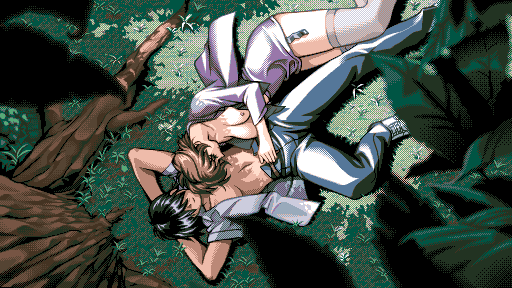
Although each of the game's leading ladies has an associated sex scene, I didn't discover Mitsuki's until well after I'd killed her off several times. Indeed, hers is the only one that isn't on the main line for her route, tucked away instead on a side branch that you have to go against your intuition to find. (Eriko's scene, which *is* on the main line, may have been intended to tide players over in the meantime.) In other words, you'd be unlikely to find it unless you were attempting 100% route completion. And you'd be unlikely to try that unless you'd already been down her route before, as a key item is down the opposite path. Despite its non-linear plot, YU-NO was written with keen intuition for the player's expectations and past experiences at any point on any branch, and plays with both wonderfully.
In the aftermath of their liason, Takuya and Mitsuki lie under a tree and discuss the life they'd like to live together. I think Kanno meant for me to find this scene when I did. And I think he meant for it to sting.
By the time I'd learned the secret of Kanna's past, I was nearing what I thought was the end of the game. I had collected seven out of the eight jewels, and had finally gained the key to Dr. Arima's study, the study in the opening scene where, as you'll remember, the final jewel was locked behind the face of a clock. Around this time, I'd written a list of questions and theories regarding who was what and what was why in this sprawling, multidimensional affair.
Who were the "Celestials?" Were they aliens? Where did their civilization go, and why did it vanish? Did Mio have Celestial blood? What did Ryuuzouji want with the reflector? The power to rewrite time? Who was this "Abel" Eriko kept referring to? Is Eriko Kanna's mother? Is Yu-no the the legendary spirit of Triangle Mountain?
It goes on like this for a bit. It's silly, looking back. But it speaks to the way the game sets its tone. I refer to YU-NO throughout this essay as a "mystery story," but it doesn't hide its clues; it bombards you with them. It's a trick of atmosphere common among games in the C's Ware library, of which YU-NO, through its shared staff, is an honorary member*, from Desire's misaligned horizon to the druggish sweet scent that follows the students of Divi-Dead's secluded boarding school. In fact, it was while playing Divi-Dead long after YU-NO had ended that I finally put this approach into words:
"[...]it hits the player with a string of quirks and coincidences that seem slightly off[...]The mystery is that it isn't clear what it all adds up to. These facts simply hang in the air, make it thick, make it heavy."
The questions stacked and stacked right to the very end. Inside Dr. Arima's study, we found the little brown book he'd been scribbling in the night he disappeared. In it, a final message to Takuya, of which his original letter was an excerpt. This memorandum recounts the development of his research, and recalls the life and death of his first wife, Takuya's birth mother, a blind blonde who arrived in Sakaimachi from an unknown, far-off place.
Returning from the study, something in the mountain reacts to the jewels, opening a secret passage. Deep below the mountain, you are given one last puzzle, one last test, and then...a screech and a blinding flash.
And then...darkness.
And then came the True Final Route, in which my roller coaster ride was brought to a grinding, screeching, heart-shattering halt.
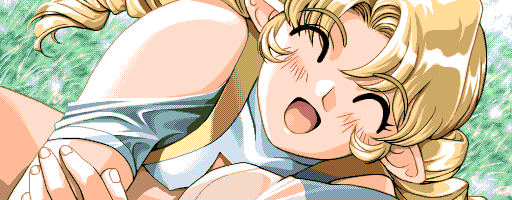
Time to meet Yu-no.
SPRING 2018
The first bad sign about the ending is that I felt compelled to document it very thoroughly in my notes when it was over. From the beginning:
I will say, again, that I was wrong about nearly everything. About Eriko (though I guess I was close,) x10 about Kanna (the woman in the photo with her isn't Eriko, actually, despite the covered face and similar physique and apparent attitude (oh great, was I led off on purpose?) but a character you don't meet until the final route,) x100 about Ryuuzouji (I still don't know what he is, but he sure as heck isn't a Celestial! And yes you do see his true form, so look forward to that, I guess) and x1000 about Yu-no.
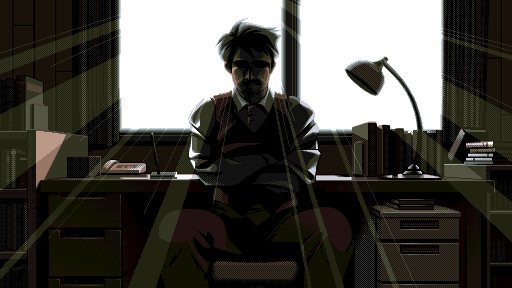
Transported to another plane of existence, Takuya is finally reunited with his father, who congratulates him on his success in the main game, and tells him of an entity called Vrinda's Tree, "which governs not only space, but all events in the universe." He claims to be drawing knowledge from this tree, and is able to speak to Takuya telepathically, learning without words about all the things his son has been put through since his disappearance. It was a hard-won moment, and to someone who had invested as many hours in the game as I had, it was the penultimate satisfaction, second only to what I was certain would come next.
As nice as it is, this reunion is brief. Dr. Arima is only the first stop on the way to Takuya's true destination. This, I assumed, would be a route in which the curtains would come down, the monsters would be unmasked, and the truth about everything would be revealed.
Where...am I?
...My head hurts...
My cheeks hurt...
...They prickle...
You begin every cycle with these lines, as Takuya slowly comes to at the foot of Triangle Mountain. Recollecting himself after being flung back through the void, he remarks that he's lost track of how many times he's found himself in this situation, repeating these lines.
But this time is different.
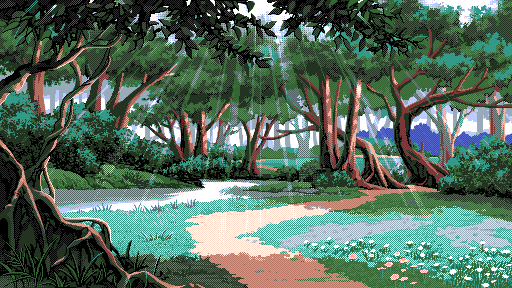
I wake up in a forest. No solution is given. Nothing is solved. Nothing is unmasked. I begin to remember bits and pieces of Azuma's plot synopsis, and as Takuya tries to determine what has happened and where he is (Ryuuzouji's courtyard? Meunji Park?) it becomes painfully clear that I am not, in fact, at the end of the game. Oh, I'd get my summation, eventually, but not quite in the way I'd expected.
Takuya is not in Ryuuzouji's courtyard.
Takuya is not in Meunji Park.
Takuya is not in Japan.
Takuya is not on Earth.
It's somewhere else, another place, another time, another world.
And the music has changed. While the music throughout the game preceding this moment has been, if not always "natural" sounding (see my word sketch of FM Synth way up above,) at least identifiably "musical," the track "Other World"—and by extension, this phase of the game, opens with a distinctly un-musical, mechanical blitter, like alien dialtones echoing out from space. It's a riff that pulls the familiar protection of the YU-NO soundscape out from under you like a rug, just as your reflector, your friends and family, and the whole of Sakaimachi is pulled out from under our hapless hero. The pitch shifts up anxiously as you escape the forest and meet with a shocking vista, nothing but wilderness extending in every direction. percussion layers on in a reprise as you chance upon otherworldly civilization (a long way off at this point, to be sure.) And although the song eventually settles into melody of its own, it never loses that far-out, inhuman aspect.
It's not difficult to imagine that the "Other World Episode"—the name for this extended epilogue, in which Takuya meets Yu-no, sees the Celestials firsthand and confronts Ryuuzouji for the last time, no guns involved—was intended to be much more than what it was. In fact, it was recently confirmed in an interview with co-composer Ryu Takami that it was intended to be a full second act of the main game, complete with its own new set of routes and items, like the Dark World half of A Link to the Past, but that this plan was curtailed due to encroaching deadlines (the game's original release barely missed Christmas Day.) Your actions in one era would even effect events in the other (Imagine, if you will, a scenario like Ocarina of Time, only Ganon's Hyrule is both past and present, and both eras effect each other cyclically.) If you squint, you can see it: Takuya's entry into the ancient city where such an act might've taken place is marked by a lengthy introductory cutscene, and he's even given a new tool, a compass with which to track divergences, which is never actually used and doesn't appear again until the credits. "Other World" itself is similar in tempo and cadence to the Main Game overworld theme, and could've served as its counterpart in the second act. (An entire essay could be written on the underappreciated motifs running through the game's soundtrack, but this one has already gotten long enough.)
YU-NO establishes and leverages its musical vocbaulary in ways you might not
immediately notice. Take for instance "Bonds," an upbeat tune that typically
plays over the game's happy endings. "Affection," the song that plays while
Another example takes some digging into the files themselves to understand.
The filename for Kanna's theme is "YUNO_22B." Letters are generally added when
a track is a variation of another one. So what's "YUNO_22"? It's called
"Nostalgia," and it plays over a scene in which Kanna shows unexpected warmth
to a neighborhood dog, a last rite taken at sunset before heading off to face a
fate uncertain even to her. The connection between the two isn't conclusively
clear, beyond a similar leading instrument that moves at a similar pace, though
it seems that where songs share a narrative or symbolic connection, their
musical connection has more to do with style than melody.
Okay, just a few words.
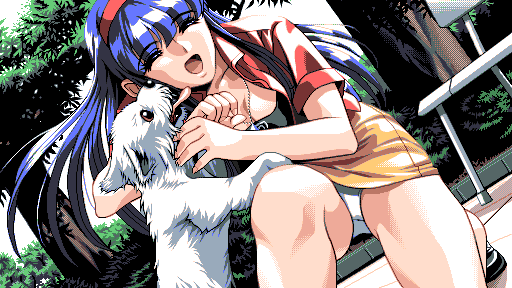

While exploring the forest, Takuya finally meets someone, an elflike blonde who struggles to speak. Could this be Yu-no? No, it's Sayless, a runaway priestess from the Imperial City. Together, they find a cottage on the edge of the woods; its dying owner, a knight, entrusts Takuya with both her home and the safety of the priestess. after a failed attempt on Takuya's part to escape, the two of them live there as husband and wife for the next four years, settling into a simple life and raising a child.
Yu-no is their child. She grows to pre-teenhood during this four-year timeskip (folks seem to age differently around here,) and reaches adulthood offscreen over the next several months, to the point that when Takuya meets her again in the city, he doesn't immediately recognize her. When you regain control after the timeskip ends, the first thing you do chat with her.
Just like meeting Dr. Arima at the end of the main game, this felt like a milestone. the answer to a question that had been hovering over the game like the shadow since she first washed up on shore all those months ago and set this splintering plot in motion. The song that plays over this character-establishing dialogue "Mischief," is full of life and youthful bounce, and when I first heard it, it sounded like nothing less than a congratulation. I'd come a long way, and I'd felt more than ever that it had been worth coming this way to get here.
And then I found out she was extremely horny for her dad.
This is the point where the game begins its gradual journey from "compelling, despite its best efforts" to the point of no return. The rest of this section will chart this journey.
It's not subtle, and it's really weird, and it comes out of nowhere. YU-NO competes with her mother for her father's attention, squeezing herself in between them at bedtime. It starts to make Takuya unconfortable, which is ironic, this is pretty much exactly how he behaved around Ayumi (well, now you know how she feels, huh?) One wonders if it runs in his family genes; Takuya's father was an even bigger pervert than him. It doesn't help that Yu-no, living in a cottage in the middle of picturesque nowhere, is isolated from any men or boys other than her father, who worries aloud that what she needs most of all at this point in her life is peers her own age (to which Yu-no responds, with a bless-her-heart smile on her face, "'Friends'? can you eat those?") It may be that, as I'd note in my journal, Yu-no is forced "to push him into every relationship role she needs, be it father, friend, or lover, because there's just nobody else to turn to."
But regardless (and there's little point trying to psychoanalze a fictional Electra, Thermian arguments being what they are,) what makes this scene important is that it's the one time the game acknowledges the possibility that Yu-no's obsession with dear Daddykins may be genuinely unhealthy, as opposed to "comically" awkward...a possibility the game unceremoniously drops after that.
It helps no one that her mother dies. Soldiers from the Imperial City arrive at the door one day, looking for Sayless, with the intent of bringing her "home," kicking and screaming if need be. They get a little carried away (she stops breathing.) Yu-no and Takuya are left alone together, a vast desert separating their cottage from the city, and the "God Emperor" who sent those soldiers across that desert to their home.
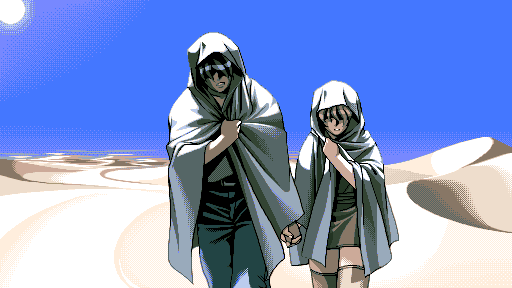
It is following this that Takuya finally leaves his home and braves the desert, with Yu-no in tow, partly in the hope that there might be friends for her there, and partly for the sake of blind revenge. Takuya has a bone to pick with this God Emperor.
The rest, to be brief, is as follows: The two reach an oasis, and after a bizarre encounter with a horny bondage elf (it makes even less sense in context, I'm afraid) they stumble upon an ancient temple. Veering too close, they are spotted by guards who carry Yu-no off and send her father to a rock quarry for an indefinite amount of hard labor. Several months later, the quarry is shaken by an earthquake; Takuya escapes in the confusion with Amanda, the leader of a rebellion against the God Emperor (how convenient!) and the younger sister of the woman who once owned Takuya's cottage. They are carried off into the desert by a dragon-girl creature called a nogard. This particular Nogard was a good friend of Yu-no's from the cottage; she happily offers herself as food when Takuya and Amanda have gone for too long without. While Amanda and the otherworlders consider Nogards mere animals, they are, to be clear, extremely anthro, and the thought of what effectively amounts to gijinka cannibalism disturbs Takuya deeply.
After eating the nogard, they return to the temple, wherein lies the Reflector at last. Shortly afterward, they reach the city, and after rescuing Yu-no from the heart of the castle, Takuya waits in the courtyard for the God Emperor to appear, sword in hand, ready to cleave his head clean off.
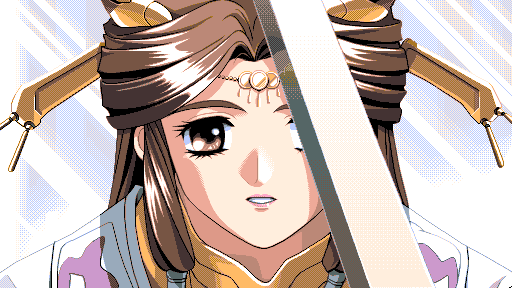
Life gets in the way.
Ayumi and Ryuuzouji, as it turns out, were transported to this faraway world that fateful night when they met you at the mountain shrine, at the same time you were whisked away to an alternate continuity, and they've been living their lives here for the past four years. Ayumi had since risen to the rank of God Emperor (or rather, Empress.) Following this botched assassination, Takuya learns the true nature of the Other World, and of his father's research, from Eriko, who has chased Ryuuzouji into this realm.
Notes on Event Science
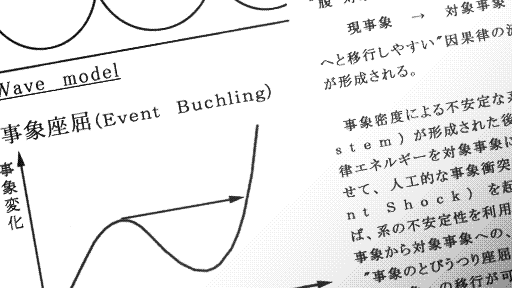
Bundled with the 2011 English translation of YU-NO is a document originally included with the official strategy guide in Japan. Titled "An Inquiry into the Fundamental Composition of the Universe," and with Prof. Yurika Imagawa—a friend and collaborator of Dr. Arima's—listed as its author, it lays out in complete detail the physical principles that undergird YU-NO's many worlds. It is incredibly dense, and it opens with some particularly intimidating mathematics, and while in terms of scientific accuracy it outright admits to abandoning the scientific method and can thus be dismisssd as pseudoscientific technobabble, as an in-universe construct it sheds light on many concepts within the game that might seem strange out of context, and as a set of symbols, it allows for some interesting readings of those concepts.
In the interest of simplicity, I have been omitting a lot about the intricacies of YU-NO's metaphysics until now. But the first critical point to establish is that the branching timelines you travel down over the course of the 50 Hours are not timelines at all. Instead, they are considered "parallel universes." To explain the difference between the two, we must first discuss events. "Events," in the context of YU-NO, are not moments in time but discrete units of causality that were first discovered as a theoretical result of the effect of faster-than-light travel on the movement of time. They are nodes along a causal chain, linked by likeness and probability.
Each event is a complete, self-contained system, functionally a snapshot of a universe but essentially a universe in itself. Dr. Arima gives Takuya the example of two universes, one in which he eats a cake prepared by Ayumi and one in which he does not. Each of these is a unique event, instantiated through the action of event elements, particles that flow from one node in the causal chain to the next, creating new events where one does not already exist ahead of them. Each of these events has its own Takuya, its own Ayumi, and its own cake (though by now there be only one cake between them.) Each one, by implication, has its own Sakaimachi, indeed its own world beyond them.
【Eriko】 Don't misunderstand. "Events" have nothing
to do with time.
According to the document, what we call "time" in everyday experience is actually the interplay of two phenomena, which can be split along two axes; while time moves inexorably onward, causality describes the web of causal nodes through which event elements flow, and the motion of those elements from one node to the next over time. One can think of the nodes as points in event space. I was right on the money, then; these events were, in fact, places I could reach out and touch.
Imagawa descibes event elements as fluid in motion, and their behavior is in some ways comparable to that of tangible objects. Just as a ball held over a balcony or a roller coaster can be said to have "potential energy," event elements can be said to have different amounts of event potential depending on their place in the stream of nodes. Events with similar potential exist simultaneously in time, and events that collide outright are annihilated like matter and antimatter.
As stated in the treatise, "The flow will prioritize directions where event potential is low or where the inertial force of the flow is high." By default, event elements to favor future nodes which can be extrapolated from prior ones with minimal effort. The world you wake up in tomorrow is more likely to resemble the world of yesterday than the world of 500 years ago or 5000 years to come.
One consequence of decoupling causality from time is that the two need not always synchronize in an intuitive way. With the right impetus, event elements can be compelled to flow towards a prior, already established event, a phenomenon referred to as a "causal eddy," analogous to the vortical eddies seen in turbulent fluid. This cyclical chain of events, which you might informally call a "time loop," continues until either the external force driving it is exhausted or a competing impetus forces the flow of events in a different direction.
Vrinda's tree is the complete, ever-growing set of all branches, its outline traced by the flow of event elements. From its shape you can divine all the events that ever were; from its motion you can divine all events yet to come. As events move back up the tree, branches converge and consolidate; at the root of all branches lies a mysterious, incomprehensibe sphere:
【Eriko】 That place is called the root of events.
【Eriko】 It's the domain of God.
【Eriko】 The truth that exposes everything about all
creation. It has to exist somewhere in the universe.
【Eriko】 The aggregation of this truth is what I call
"God," in the literary sense of the word.
This doesn't cover everything (I encourage those of you already playing to stop and give the Inquiry a read,) but it makes certain quirks of the story easier to understand.
If all parallel worlds are distinct, and every instance of yourself is a copy of a copy of a copy, can you be sure that you're same person you were last year, the same person you were last week, or even the same person you woke up as? Where is the persistent "self" in this reel of snapshots? This is a variation of an old philosophical question, a question made ever stickier by the doddering nature of time itself in YU-NO's world. When Ayumi frets at the end of her route over whether the Takuya she's talking to is "the Takuya I've come to know," her concern is with the existential implications of becoming intimately entangled with what, to her, is just a copy of an original. Whichever Takuya once existed under her roof was replaced with you when you entered her parallel world, and you have been through so many new experiences since the beginning of the game that you and your doppleganger may no longer qualify as the "same" person, if you ever did. When Takuya tries to assuage her fears, he is affirming the idea of a persistent self, one that transcends any single moment in time:
【Takuya】 I'm not too sure about that. But, you're
still the Ayumi-san I know, and I'm still Takuya. These
facts won't change, right?
It is also clear that characters who disappear in YU-NO may not be truly gone. When our mysterious beachside blonde is "cast off into the flow of causality," it is not unlike when Ayumi perceives Takuya's body as beginning to vanish at the end of her route. When you open up the menu after a terminally bad ending, It is depicted strangely in-universe, as Takuya reaching out for a button in the darkness while being administered a lethal injection with his whole body numb, or standing in a void with Kanna after an entire has collapsed over him and crushed him.
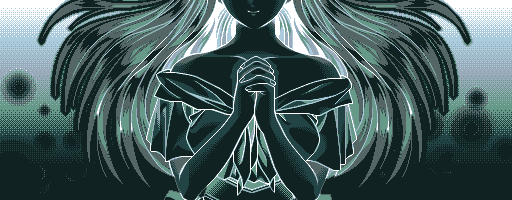
That is to say, he sometimes warps back in circumstances where outside observers would consider him already dead.
When Sayless dies, Yu-no later says that she can still hear her voice, and that she lives on in her heart. While you might be tempted, as Takuya is, to write this off as a mere kitschy metaphor, Yu-no goes on to say that her mother confided to her a long time ago that she not only foresaw her death but was powerless to prevent it. And what she told her next is altogether haunting:
【Yu-no】 "But I won't die. I will set out on a journey"
to save you and Papa." she said...
More haunting still, when you consider an earlier scene, set before her death, in which a voice, implied to be hers, calls out to Takuya's subconscious in his sleep, promising to save him as he saved her in the desert, an event yet to occur (and which does eventually occur in the story, to be clear) but to her already a distant memory. The voice is set against a surreal backdrop; it echoes from a place where time itself seems to melt into vapor.
The capstone on this pyramid of anomalies is her death itself:
Sayless is not killed by the soldiers. Sayless commits suicide.
(And by biting her tongue, in a twist of twisted irony.)
This would seem a minor, if unfortunate, detail...except that this is also how
Takuya's birth mother died, and that moments before, she tells Koudai this:
"I am not myself. I must set off on a journey for the sake of the next in line... farewell."
When Dr. Arima himself addresses Takuya in the memorandum, after he is assumed dead by the world (yet confirmed alive by Kanna,) he says:
"I have set off on a journey. A journey in order to face the circumstances imposed upon me - you might call it my fate."
And do you remember what Takuya said about the strange blonde from the seaside?
It is never said up front, but you can't help but wonder whether there is any connection between these happenings and the ghostly images of Sayless you see in the opening scene and under Triangle Mountain. You can't help but wonder whether the mysterious phone calls the Arima family receives are interference, intentional or otherwise, from nearby worlds or nearby travellers, invisible but ever-present. As many of you playing the game were torn by Sayless's death, it may bring you some comfort to consider that, perhaps, she is always watching over you.
The mathematics of YU-NO's time travel first appear at the beginning of the game, as part of a set of documents that comes packaged with the Reflector. When I first saw them, I wrote them off them as superficially smart-sounding filler. I was surprised to find, instead, that these laws form the lynchpin of the entire plot(s).
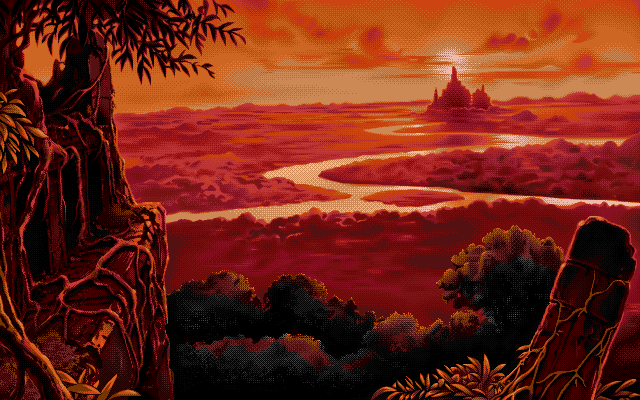
The "Other World" Takuya falls into is a country called Dela Grante. Its inhabitants are an intelligent pre-human species who escaped their impending doom by cosmic impact by attempting to launch themselves into a parallel universe in which the impact does not take place. In fact, they were thrown into interdimensional space; here is our "island floating through the void."
At present, they are trapped in a causal eddy: Every 400 years, they risk an event collision with the standard 50-hour Sakaimachi timeline, which, as we've just covered, would annihilate both worlds. Every 8000 years, a failed landing procedure will result in a *physical* collision with Sakaimachi itself or, to be precise, the area that Sakaimachi will one day inhabit (the ruins of Triangle Mountain are, of course, remnants of their former continent.)
This 400-year cycle of crisis is referred to as "The Wrath of Mother Nature" to the native people, who have long since forgotten that their world is a ship in an ocean of time, and see the earthquakes that rise in frequency and intensity as the fated date arrives (one of which toppled the rock quarry where Takuya and Amanda laid captive) as a kind of divine fury. The job of a Dela Grantian Priestess, as Sayless was, is to avert this cycle by merging her consciousness with the computer that steers the ship in a form of ritual sacrifice, and piloting it manually out of harm's way. After Sayless died, a member of her bloodline was discovered and carried off to take her place...
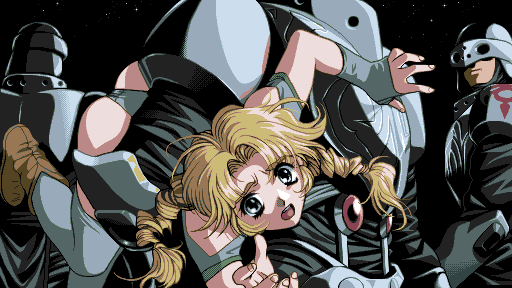
...Forcefully, if you'll recall.
In preparation for this rite, each priestess must give up a certain physical faculty. Sayless (her name a pun on "Celes") gave up her voice; Keiko, herself a former priestess, gave up her sight. Yu-no, though physically unchanged, had to spend her nights in a brainwashing chamber, making her temporarily forget who Takuya is, and even point a sword at him when they meet again in the city. When the soldiers attacked and killed Sayless, it was because she broke her vow of silence, screaming in panic as the old cottage owner, a knight named Elly, arrived just in time to save her from a monster and was fatally wounded.
The problem with the sacrifice, the reason Sayless ran away to begin with, was that was exactly that, a sacrifice. The merging process was officially said to kill the priestess who performed the rite (and the road to the city is lined priestess-shaped coffins,) though the truth is perhaps even worse: The priestess-pilot is jettisoned into the interdimensional void. There's a chance of survival by dumped into a random point on the causal tree, but the chances are a billion to one, so it's hard to say whether this is a fate better or worse than death.
Understandably, Yu-no is concerned and her father is terrified.
She resolves to commit regardless, and Takuya forbids it.
Things become strained between them...though not for long.
If you happen to have been playing this game at all long enough to get a feel for its route structure (and this is a route, remember,) you might be starting to worry about where this story is going. You might be starting to worry, in fact, that there is only one direction this story can go in, however contrived. It's worth coming back, as we approach our story's event horizon, to some of the strangeness surrounding Dela Grantian puberty.
Though by now you've seen at least a few pictures of the Girl who Chants Love, they're all from before she "grows up" in the Imperial City. By the time Takuya finds her there, she looks closer to 20 than 12:
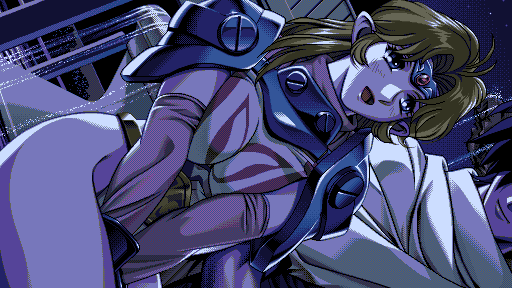
But is she really an adult? Just a few months ago she was asking if friends were a thing you could put in your mouth, and her cartoonishly innocent personality doesn't change at all between then and now; it only gets more dissonant the older she looks. She's like the inverse of those thousand-year-old dragon lolis; despite having the body of an adult, she's only four-and-a-half...and she comes off as the type who'd make a point of emphasizing the half.
And of course, she doesn't let up on Papa Takuya. And of course, her interactions feel slimier and slimier. And I'm sitting here with a twitch in my eye and a twinge in my fingers, and a slinking, sinking, stinking sense of dread, the kind of dread a person has in the presence of God or Fate. I couldn't say for sure how bad this was going to get. At this point, I was just crossing my fingers and hoping it didn't hit rock bottom.
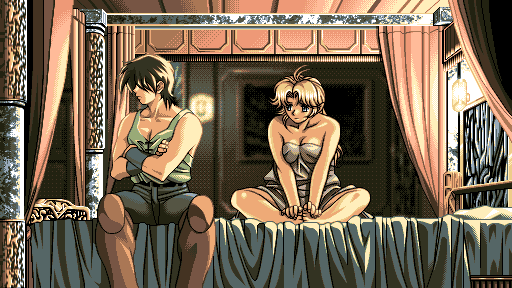
Once more, with feeling: Life gets in the way.
It happens the night before the rite. Yu-no appears in Takuya's bedchamber to vent her fears and frustrations. Takuya tries to console her. Expecting death, she admits her feelings for him and makes one final, unspeakable request. Takuya relents at first, but...
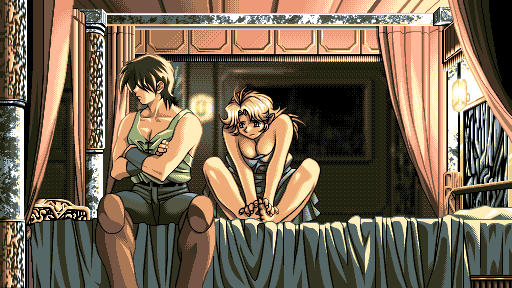
Oh no...
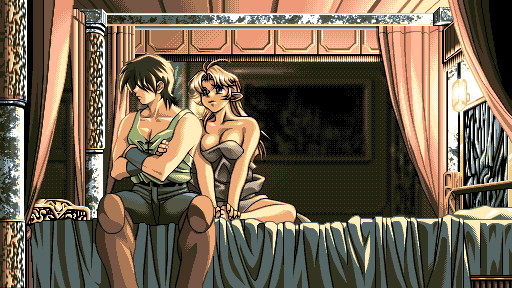
Oh noo, nooooo...
【Yu-no】 What's a "law"?
NoooOOOoooOOOoo...
【Takuya】 Just so you know, an adult's loving might
be pretty intense for a child.
TAKE THIS CUP AWAY FROM ME!
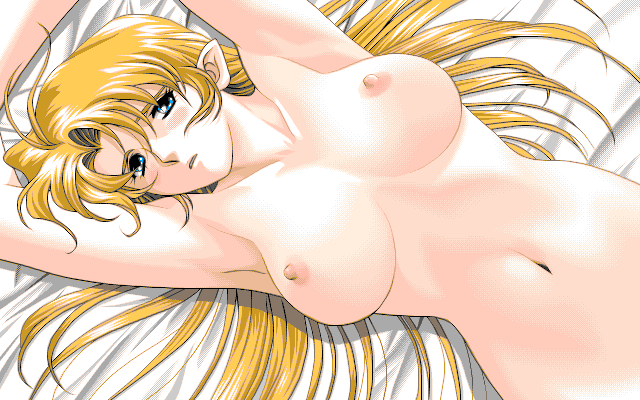
【Yu-no】 Ah, Papa...I feel kinda...
All the blood drains from my face into Takuya's dick.
The rest goes by in a haze. Ryuuzouji interrupts the rite, trying to railroad Dela Grante into annihilation. He sheds his body and transforms into a spectral demon, before being curtly shot in the back by Eriko (though not before shanking Ayumi, I'm afraid.) The rite is completed at the last minute, and Takuya slips away just before the phsyical collision occurs. He slips Yu-no one of his jewels, though, which she uses to find her way back to him at Sakaimachi...the long way around.
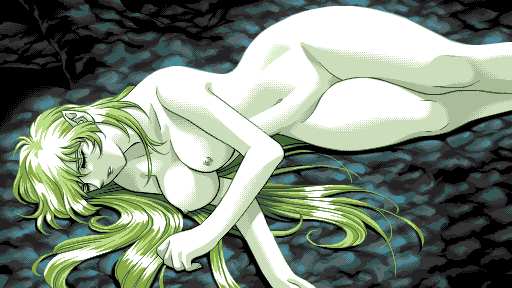
The story closes as it opened, on a familiar evening, with a familiar chill in the air. Takuya finds himself on a familiar shore, on which a familiar blonde body has appeared, lying in a familiar position on the rocks. But now all the jewels are in hand. When the appointed hour tolls, and Yu-no rises to meet him, the two are spirited away into the stream of events, and the Hell cycle of Chaos Correction is finally broken.
The ending is a little bit Gainaxy-weird, as the two of them arrive at an unknown point in space and time where a sapling, all alone in the void, is taking root. This root, in fact, is the root of event space, a little Vrinda's sprout that grows explosively, pluming up into the black sky overhead and multiplying its branches at the speed of light. The final shot of the game is of the two of them standing in the cool of the day, under the shade of Vrinda's tree, at the root of all creation.
I suppose this could be seen as an interesting ending, to the right sort of person. A reading that interprets the game's causal eddies as a metaphor for cycles of reincarnation is not unthinkable, as the concept of samsara is named outright in Imagawa's treatise as a forerunner of modern Event Science, and the lightning that bursts from the tip of Triangle Mountain is compared to the Light of Indra when seen in an ancient painting, showing, if nothing else, that such connections to religion and philosophy are not confined to auxiliary material. I guess someone could find something there, if they wanted to, maybe. But by now my brain is completely fried.
I wanted to believe YU-NO could fly, and it did.
It flew right into the fucking sun.
********
October 2019
I'll let you in on a little secret. I've been planning to write this since Mio in the cave, since 2017. It got away from me for a while (once more, with feeling!) but I'd been scribbling bits and pieces of it out all along. "Nobody plays YU-NO" was from back then. I was satisfied enough with that introduction that I didn't want to rewrite it, but it feels different, saying that today.
It's 2019. People play YU-NO. It recently ran a successful animated adaptation, and has been remade for several platforms; the Windows port was released earlier this month. It hasn't taken over the news by any stretch, but this is still the most popular the game has been since the '90s. If you've been hearing about it from friends and strangers and don't know what it is, well, now you do.
And in all fairness, its legacy outside Japan has been steadily growing since the days when the most you could learn about it was as a footnote in a book from 2001. Being one of the relatively few PC-98 games available in English, and having been first translated eight years ago, it's become one of the platform's flag-bearers overseas, along with the likes of Corpse Party and Touhou. It was referenced as one of several inspirations for the PC-98 tribute album Tree of Knowledge (the similarities in mood and pacing between the first track of the album and YU-NO's own opening theme should be immedately apparent,) and is a regular topic in the increasing amount of coverage given to the PC-98 by Youtubers and games journalists alike. Much of the anime's popularity outside Japan can be attributed to the wealth of word-of-mouth promotion being spread via the game's existing fan base from the moment it was announced.
I'd been planning to write this since 2017, and back then, I'd expected (hoped) to end it differently. With a recommendation, maybe, a call to at least dip your toe in the water and wade around until you knew whether you wanted to stay. As the game wore on, though, the endings I had planned grew less and less enthusiastic. The longer it had been since completing the game, the more disappointment calcified into disillusionment, and the more I began to think back on all the little things, the little things I'd ignored or filtered out in the moment because, again, I wanted to believe, naively to be sure, that it would turn out alright in the end.
It's possible for a game to be trashy as heck and remain endearing in spite of itself (That's what Hentai Quotes are for, duh.) It's possible for jankiness and roughness to work in a game's favor, for it to fold back into a kind of pleasureable friction that makes its hidden highs feel more valuable, memorable and satisfying. And it is possible for that jank to come from being terminally horny, actually (guys, guys, tell them about the Prince CD-ROM game.) But describing YU-NO as that kind of game might be too forgiving.
So, little things. I kept remembering the little things. Little things like that one girl in a tight black dress Takuya tries to lick before recoiling in horror because oh no, it's a dude! Little things like Takuya's running-gag tendency to "accidentally" walk in on women changing, or "accidentally" walk in on them in the shower, or "accidentally" take their skirts off. Little things like how you can set the game's home screen wallpaper to various H-scene CGs—for fapping to, you can imagine—and how one of these supposed tissue-pluckers is a shot of the Woman in the Black Dress, raped and brainwashed, drooling, pupils empty, semen leaking from her bloody crotch.
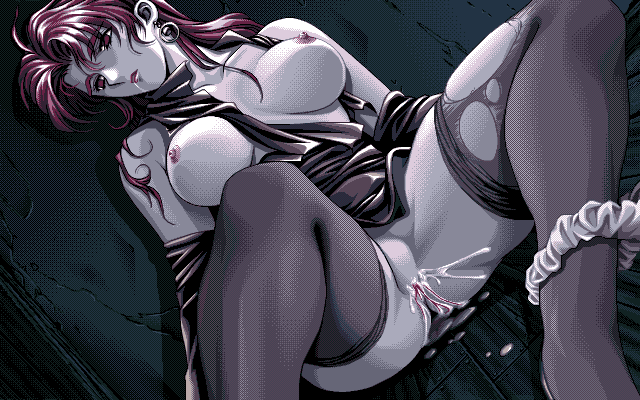
I could go on, really. For a while I wasn't certain how to end this, but I think I know now. The truth is that I'm not really writng this so that you'll play YU-NO. I don't think you have to, and I don't think you should feel like you have to.
(The truth, for truthfulness' sake, is that I'm writing this because I've been writing it for too long and I want this to finally be done and over and out of my head so I can move on with my life. Break the Hell cycle, as it were.)
In fact, I'll take a step further and say that I can't recommend YU-NO to anyone reading this as a matter of principle. It's the reason I haven't included links to the 2011 translation and the 2001 ISO it's designed to work with (not that they're hard to find anyway, even if the translation homepage has been down for ages.) Some of you might counter in response that all the proof you need of YU-NO's recommendability can be found on this very page. And yes, all of the things I've said up to now about time and aesthetics still stand, but I'm not sure if they matter anymore, or if they matter enough.
Part of me thinks that I'm going crazy, that I've projected so much onto this game that it has become something divorced from reality in my mind. Normally, the remedy to that would be to write essays like these, so that other people could learn about the game, and try it for themselves, and see for themselves whether my own assessment holds up. Normally, I'd be delighted at the thought of such engagement, but asking for it here feels either unethical or fraught.
YU-NO is a messy piece of work. But this time, for once, "messy" does not mean "exempt" or "absolved" or even "redeemable". It means it's a mess. God, what a mess. It's a very pretty mess. It's a mess with things to say. But it's still a mess, and there's a looooot to unpack before praising it out of hand, before talking about it at all. Call it overreacting if you want, but I'd like to encourage more readings of messed-up works that don't force you to take the good with the bad, or to sweep the bad under the rug for the sake of the good. I'd like, at the very least, for you to know what you're getting into.
I have no trouble admitting that YU-NO was important to me. It sparked an obsessive deep dive into the PC-98, Japanese graphical adventure games, and eroge, a deep dive out of which I emerge noticeably changed, a dive that hasn't really ended, a dive that ran concurrently to that initial playthrough and only intensified after the game ended and left me desperately trying—in vain, I'd learn—to find something that could replace it. But it's precisely because it was such a big deal to me that I am cautious to overlook anything about it anymore. I'm cautious of the defensiveness that tends to sprout when you want to overlook the "little things" about the big things in your life, and of what that defensiveness tends to grow into.
Maybe you've seen this process before. Maybe you've seen someone shrink and
curl up and lash out because this thing is so important to them and am I not
allowed to care about this anymore and I'm not bad, stop trying to call me bad,
I don't approve of these bad things, I don't but you all think I'm monster,
well, maybe I am, maybe I am now and it's not so bad, maybe all art is
problematic, and you know what I changed my mind, these bad parts are good
actually and I love them now and I hate you all so much and is it really wrong
to want to sniff a nine-year old's panties anyway, you're the bad ones for not
being open-minded you stupid
It is very easy to become this person.
I sincerely don't know if "I refuse to call YU-NO a great game, despite all the
great things about it I just spent thousands and thousands of words listing" is
an excessive take; I've never had to deal with a situation like this until now,
and I haven't had to since (I've learned to check my expectations and never
over-invest (which, on the other hand, means I will probably never have an
experience quite like this ever again. Bittersweet, I guess.)) I don't know how
other people cope with conflicts like these; just between us, I'm a little
jealous of how easy they make it look. I'm just trying to navigate it as best I
can. And I think going "but what are a few spurts (lel) of lewdness to the King
of Visual Novels?" is, frankly, a horrible first step.
I'm done with this game, and I don't see any reason to come back to it any time soon. But one of my primary goals in writing this piece was to get across to you what it felt like for me to play it. And if you're upset that a perfectly nice-sounding writeup took an unpleasant turn for you at the very end...well, I guess I have the twisted comfort of knowing I've succeeded.
********
"Trying to find what info I could about the game, I could only scrape together a few download pages and an enthusiastic, if vague, HG101 article." I decided that wasn't enough. There were many things about the game that I felt weren't being said, for better or worse, at least not in English, and although I no longer expect this to become the YU-NO essay to anyone, I think it was still worth writing for the chance to say as many of these things as humanly possible.
But I haven't said it all. In the interest of brevity, my synopsis leaves out countless details (Why did Ryuuzouji want to pull a DELTREE on Dela Grante? And how did Eriko get there, anyway?) Likewise, the topics raised (samsara, Keogh, Beautiful Dreamer etc.) are raised as starting points for further discussion and analysis among those in the YU-know. They are an array of threads to follow. They are a web of routes to choose.
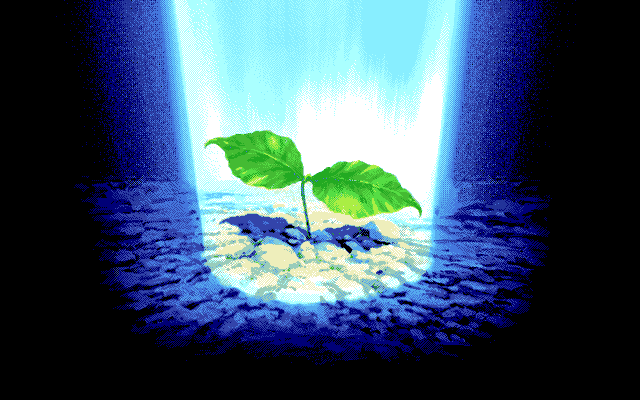
The development from here, as always, is left to each reader.
See you in another world.
